[1]
E. Casanova-Batlle, A. J. Guerra, and J. Ciurana, 'A novel direct ink writing manufacturing system to 3D print highly concentrated silk fibroin', Procedia CIRP, vol. 110, p.231–235, 2022.
DOI: 10.1016/j.procir.2022.06.042
Google Scholar
[2]
A. Bucciarelli and A. Motta, 'Use of Bombyx mori silk fibroin in tissue engineering: From cocoons to medical devices, challenges, and future perspectives', Biomater. Adv., vol. 139, p.212982, Aug. 2022.
DOI: 10.1016/j.bioadv.2022.212982
Google Scholar
[3]
H.-Y. Wang, Y.-Q. Zhang, and Z.-G. Wei, 'Characterization of undegraded and degraded silk fibroin and its significant impact on the properties of the resulting silk biomaterials', Int. J. Biol. Macromol., vol. 176, p.578–588, Apr. 2021.
DOI: 10.1016/j.ijbiomac.2021.02.100
Google Scholar
[4]
M. Peifen et al., 'New skin tissue engineering scaffold with sulfated silk fibroin/chitosan/hydroxyapatite and its application', Biochem. Biophys. Res. Commun., vol. 640, p.117–124, Jan. 2023.
DOI: 10.1016/j.bbrc.2022.11.086
Google Scholar
[5]
Z. Montaseri, S. S. Abolmaali, A. M. Tamaddon, and F. Farvadi, 'Composite silk fibroin hydrogel scaffolds for cartilage tissue regeneration', J. Drug Deliv. Sci. Technol., vol. 79, p.104018, Jan. 2023.
DOI: 10.1016/j.jddst.2022.104018
Google Scholar
[6]
E. Casanova-Batlle, A. J. Guerra, and J. Ciurana, 'Continuous based direct ink write for tubular cardiovascular medical devices', Polymers, vol. 13, no. 1, p.1–16, 2021.
DOI: 10.3390/polym13010077
Google Scholar
[7]
E. Wenk, H. P. Merkle, and L. Meinel, 'Silk fibroin as a vehicle for drug delivery applications', J. Controlled Release, vol. 150, no. 2, p.128–141, Mar. 2011.
DOI: 10.1016/j.jconrel.2010.11.007
Google Scholar
[8]
D. N. Rockwood, R. C. Preda, T. Yücel, X. Wang, M. L. Lovett, and D. L. Kaplan, 'Materials fabrication from Bombyx mori silk fibroin', Nat. Protoc., vol. 6, no. 10, p.1612–1631, Oct. 2011.
DOI: 10.1038/nprot.2011.379
Google Scholar
[9]
E. Casanova-Batlle, A. J. Guerra, and J. Ciurana, 'Characterization of direct ink write pure silk fibroin based on alcohol post-treatments', Polym. Test., p.107784, Sep. 2022.
DOI: 10.1016/j.polymertesting.2022.107784
Google Scholar
[10]
V. Chausse, C. Iglesias, E. Bou-Petit, M.-P. Ginebra, and M. Pegueroles, 'Chemical vs thermal accelerated hydrolytic degradation of 3D-printed PLLA/PLCL bioresorbable stents: Characterization and influence of sterilization', Polym. Test., vol. 117, p.107817, Jan. 2023.
DOI: 10.1016/j.polymertesting.2022.107817
Google Scholar
[11]
Q. Luo et al., 'Degradation Model of Bioabsorbable Cardiovascular Stents', PLoS ONE, vol. 9, no. 11, p. e110278, Nov. 2014.
DOI: 10.1371/journal.pone.0110278
Google Scholar
[12]
N. (Nadine) Ding, S. D. Pacetti, F.-W. Tang, M. Gada, and W. Roorda, 'XIENCE VTM Stent Design and Rationale', J. Intervent. Cardiol., vol. 22, pp. S18–S27, Apr. 2009.
DOI: 10.1111/j.1540-8183.2009.00450.x
Google Scholar
[13]
M. Puerta, M. S. Peresin, and A. Restrepo-Osorio, 'Effects of Chemical Post-treatments on Structural and Physicochemical Properties of Silk Fibroin Films Obtained From Silk Fibrous Waste', Front. Bioeng. Biotechnol., vol. 8, p.523949, Dec. 2020.
DOI: 10.3389/fbioe.2020.523949
Google Scholar



